Difference between revisions of "Managing the Legend in the Chart for Version 7.0"
(→Global Controls for Showing or Hiding the Legend) |
(→Global Controls for Showing or Hiding the Legend) |
||
| Line 82: | Line 82: | ||
7) Discussions on the '''Legend''' controls in the '''Chart Properties''' form's '''Legend''' tabs for OnePager Pro and Excel can be found at these two links: | 7) Discussions on the '''Legend''' controls in the '''Chart Properties''' form's '''Legend''' tabs for OnePager Pro and Excel can be found at these two links: | ||
| + | <center> | ||
| + | {| class="wikitable" | ||
| + | | [[New Legend Controls for Version 7.0 (OnePager Pro) | New Legend Controls for OnePager Pro]] 15.4.1-70 | ||
| + | | [[New Legend Controls for Version 7.0 (OnePager Express) | New Legend Controls for OnePager Express]] 15.4.2-70 | ||
| + | |} | ||
| + | </center> | ||
1) To hide/unhide the legend, follow the steps described below. | 1) To hide/unhide the legend, follow the steps described below. | ||
Revision as of 15:59, 9 October 2019
Contents
About Managing the Legend
1) The capability to use the color dimension in the chart to reflect differences between task/milestone shapes is one of the most significant features of OnePager.
2) The Legend is the displayed component that communicates the meaning of each color to your audience with respect to tasks and milestone shapes in the chart.
3) Accordingly, OnePager provides you total control over the color dimension in your OnePager charts and snapshots through a control structure that begins when the chart is first created and throughout your project as needs change.
4) The "legend can be shown or hidden in the chart as your needs dictate, but a certain amount of thought about the color dimension is recommended before creating your first chart from you Microsoft Project or Excel source plan.
5) If you are already knowledgeable about this subject, you may prefer to skip the next sub-section and continue on at this point: Showing and Hiding the Legend 15.1.1-70
A Discussion On Setting the Color Dimension
6) When you are first creating a chart your first opportunity to address the color dimension is when you select the Microsoft Project or Excel field that is to be used to create task/milestone shape colors in the chart.
- a) This first opportunity is presented in the OnePager choices (OPC) form's second page as shown below:
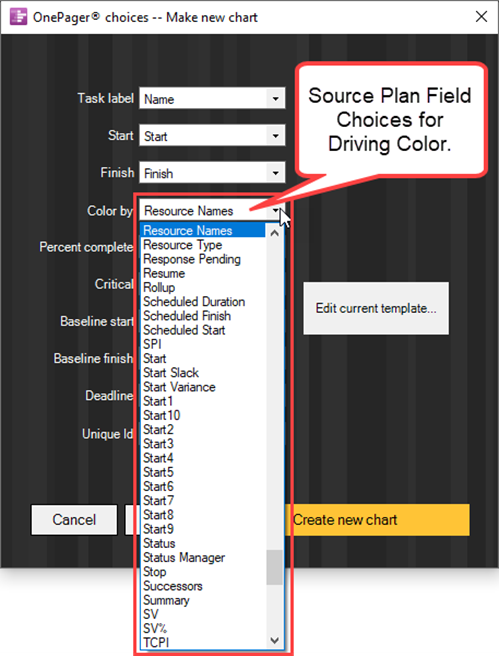
- b) The Color by dropdown contains a list of all source plan fields that OnePager encountered in its initial import of your source plan's data. As a short aside, the Conditional Import Filters feature should be a considered factor as well more about this can be found at this link: Conditional Import Filters (Portal). 7.18.1-70
- c) The initial selection of Resource Names in the illustration above is taken from the current Template form's Task Bars or Milestone tab's Task Bars/Milestone Fill Color control group being used in the process to create the chart as shown here:
- d) Shown in the above illustration, the Color-code based on radio button is selected and the Microsoft Project or Excel field name of Resource Names is selected from the dropdown list.
- e) Selecting another Microsoft Project or Excel field for the Color-code based on window in the Template form also changes the value in the Color by dropdown list field selected in the second page of the OnePager choices (OPC) form also shown above.
- f) Regardless of whether the Template form is updated as described above or you continue to use the original Color-code based on value for the color dimension in the chart, clicking the Create New Chart button at the bottom of the second page of the OPC form produces the first chart in the Chart Editor using the selected Microsoft Project or Excel field to drive the color selection.
6) As a convenience, OnePager, when creating the first chart, uses a round-robin color assignment scheme to assign specific colors to task/milestone shapes based on their corresponding value found for the Color-code based on field. That is, all task/milestone shapes in the chart with the same value for Resource Names in this case display the same color.
7) A typical chart is shown below where the Color-code based on value is Resource Names and the round-robin color assignment scheme is used:
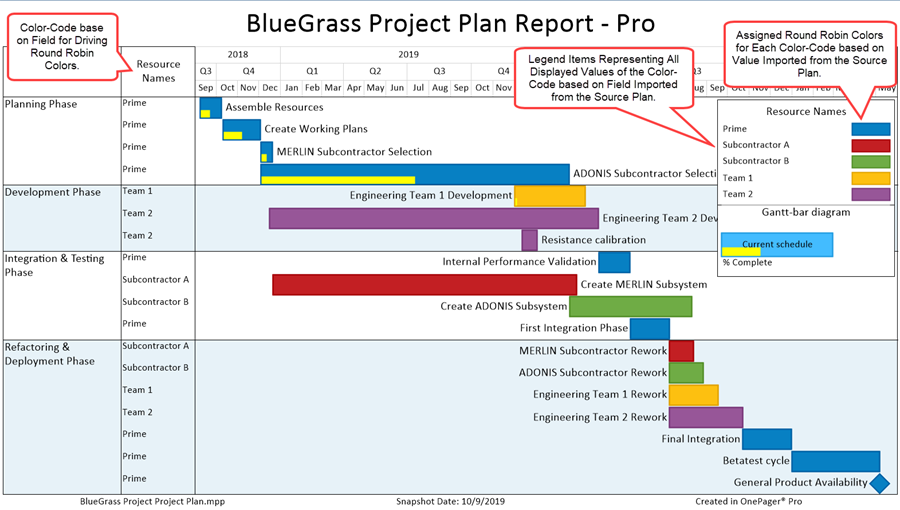
8) Once the chart is created, OnePager assures that the same colors representing the values of the selected Color-code base on value for each task/milestone shape is maintained as snapshots are added to the chart as your project continues.
9) This feature assures that there is color use continuity including within the Legend for all snapshots as long as you do not manually maverick or change the color assignments later on.
10) Reference is made to the other articles in this series that deal with detailed editing, positioning, and the controls provided to accomplish these functions in the table below:
11) The remainder of this article overview the structure of the legend, how to show or hide the Legend in the chart, and the controls for making edits to Legend components such as its Title, Legend Items, and task/milestone shape colors and shapes.
12) For additional information on editing task/milestone shapes and text labels in the chart, please consult this article series: Manual Editing Task/Milestone Shapes and Text Labels (Portal) 9.0.1-70
Showing and Hiding the Legend
1) Given the assumption that the chart is created with a Legend being displayed, you have controls available to show or hide the Legend as required.
Global Controls for Showing or Hiding the Legend
2) The Template form was mentioned earlier in the context of establishing the color dimension for the chart.
3) The Template form has a Legend tab containing sufficient controls for establishing global setting for the Legend as shown below:
4) The governing control is the Show legend checkbox.
5) Checking the Show legend checkbox On enables all the controls in the tab and, when the Save and use button at the bottom of the form is clicked, the Legend appears in the chart.
6) Checking the Show legend checkbox Off disables all controls in the tab and, wen applied, the Legend is no longer visible in the chart.
7) The controls in the Template form's Legend tab are replicated in the Chart Properties form's Legend tab.
7) Discussions on the Legend controls in the Chart Properties form's Legend tabs for OnePager Pro and Excel can be found at these two links:
| New Legend Controls for OnePager Pro 15.4.1-70 | New Legend Controls for OnePager Express 15.4.2-70 |
1) To hide/unhide the legend, follow the steps described below.
2) Go to the View tab, and locate the Legend checkbox. Uncheck the checkbox to hide the legend, as shown below:

3) To unhide the legend after hiding it, ensure that the Legend checkbox is checked.
Moving and Resizing the Legend
1) To move or resize the legend, follow the steps below.
2) Left clicking anywhere on the legend selects it, as shown below:
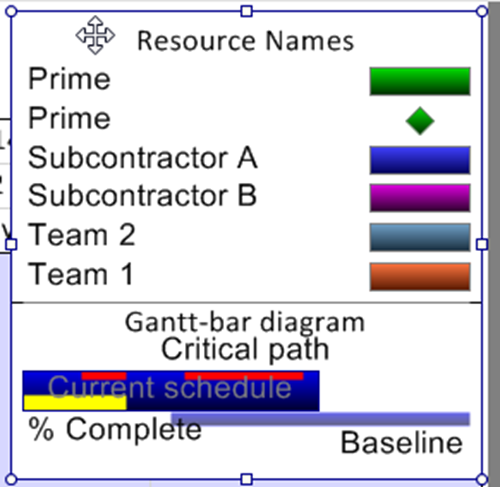
3) After selecting the legend, you can:
- a) Drag the legend to any other location in the document area.
- b) Use the grab boxes to stretch or shrink the legend to the desired size.
Showing and Hiding Individual Legend Items
1) In addition to hiding the entire legend, you can hide individual legend items. This is useful if the legend has duplicate entries and needs to be simplified.
2) To hide a legend item, right click the desired legend item, as shown below:
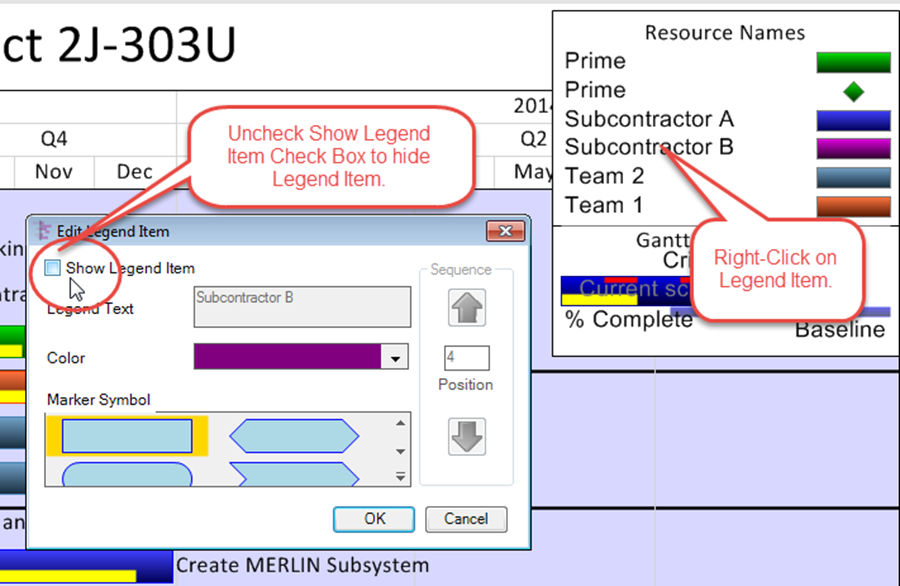
3) Uncheck the Show legend item checkbox.
4) Legend items can always be unhidden later. To do so, right click the legend (near the title) and select Unhide all items from the context menu:
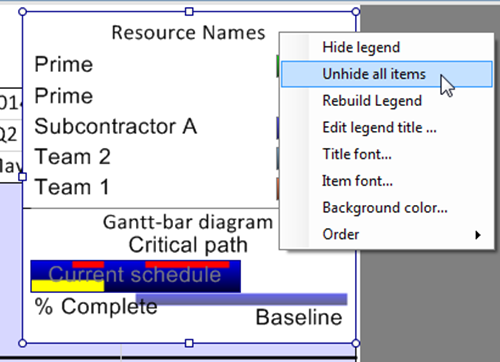
Related Links
Conditional Import Filters (Portal) 7.18.1-70
Manual Editing Task/Milestone Shapes and Text Labels (Portal) 9.0.1-70
(15.1.1-70)